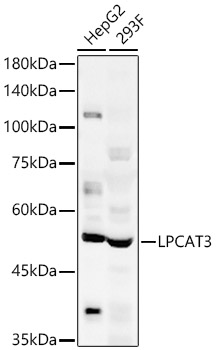LPCAT3 Polyclonal Antibody
For reference only. Please follow the manual included in your kit for instructions.
Catalog Number
Product Name
LPCAT3 Polyclonal Antibody
Catalog Number
RD90220A
Clonality
Polyclonal
Purification Method
Affinity purification
Isotype
IgG
Host
Rabbit
Background
Lysophospholipid O-acyltransferase (LPLAT that catalyzes the reacylation step of the phospholipid remodeling process also known as the Lands cycle. Catalyzes transfer of the fatty acyl chain from fatty acyl-CoA to 1-acyl lysophospholipid to form various classes of phospholipids. Converts 1-acyl lysophosphatidylcholine (LPC into phosphatidylcholine (PC (LPCAT activity, 1-acyl lysophosphatidylserine (LPS into phosphatidylserine (PS (LPSAT activity and 1-acyl lysophosphatidylethanolamine (LPE into phosphatidylethanolamine (PE (LPEAT activity. Favors polyunsaturated fatty acyl-CoAs as acyl donors compared to saturated fatty acyl-CoAs. Has higher activity for LPC acyl acceptors compared to LPEs and LPSs. Can also transfer the fatty acyl chain from fatty acyl-CoA to 1-O-alkyl lysophospholipid or 1-O-alkenyl lysophospholipid with lower efficiency (By similarity. Acts as a major LPC O-acyltransferase in liver and intestine. As a component of the liver X receptor/NR1H3 or NR1H2 signaling pathway, mainly catalyzes the incorporation of arachidonate into PCs of endoplasmic reticulum (ER membranes, increasing membrane dynamics and enabling triacylglycerols transfer to nascent very low-density lipoprotein (VLDL particles.
Immunogen Information
Immunogen
Recombinant fusion protein of human LPCAT3
Gene ID
10162
Swissprot
Q6P1A2
Synonyms
C3FLPCATLPLAT 5LPSATMBOAT5OACT5nessyLPCAT3
Observed MW
49kDa
Applications
Reactivity
Human,Mouse,Rat
Tested Applications
WB
Conjugation
Unconjugated
Dilution
WB 1:500-1:2000
Concentration
1mg/mL
Storage Buffer
PBS with 0.01% thiomersal,50% glycerol,pH7.3.
Storage Instructions
Store at -20°C Valid for 12 months. Avoid freeze / thaw cycles.
